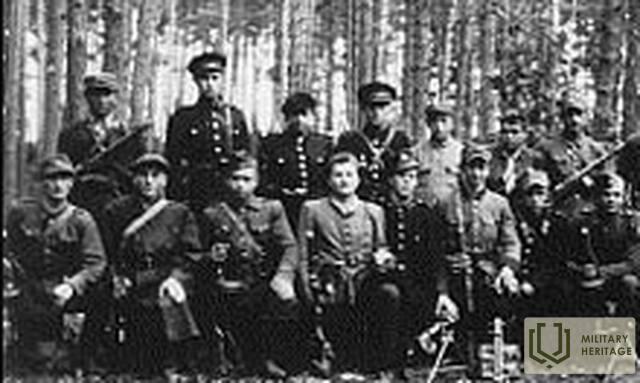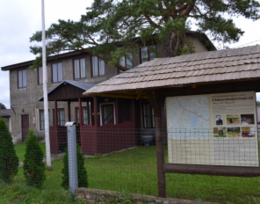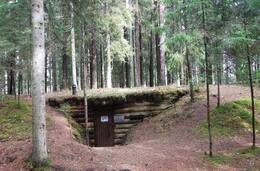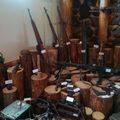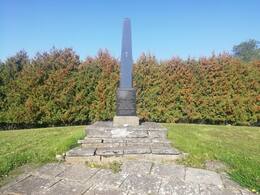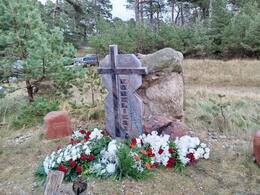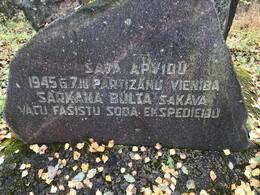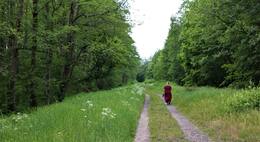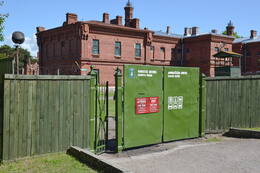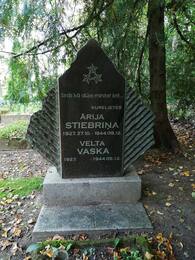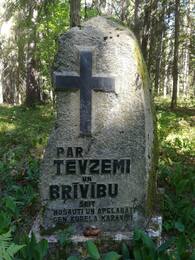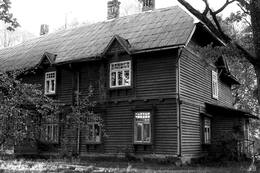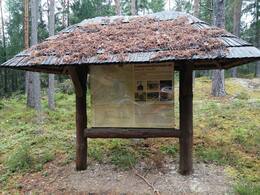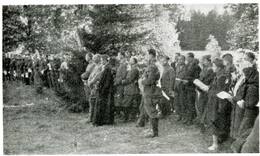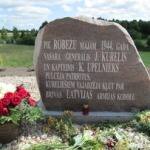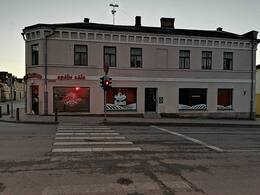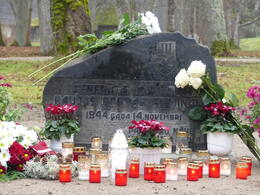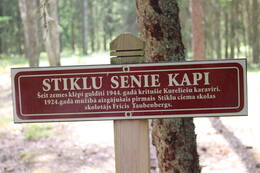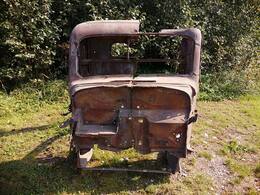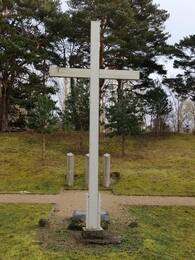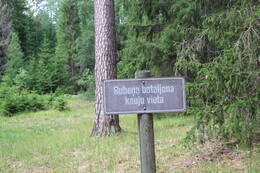kureliečiai II WW2
1944 m. liepos mėn. generolo Jāņo Kurelio iš Rygos apygardos Aizsargi (pažodžiui „gynėjai“) įsteigta latvių karinė formacija, kurios oficialus tikslas buvo ginti Dauguvą tarp Pļavinių ir Ķegumo vokiečiams pasitraukus ir suformuoti partizanų grupes sovietų pajėgų užnugaryje.
Generolas Kurelis buvo Nacionalinio pasipriešinimo judėjimo karinės komisijos, priklausančios Latvijos centrinei tarybai, vadovas, tačiau tikrasis komisijos vadovas buvo kapitonas Kristaps Krišs Upelnieks.
1944 m. rudenį persikėlus į Kuržemės kraštą, kureliečių tikslas buvo kovoti su dviem okupacinėmis valstybėmis – nacistine Vokietija ir Sovietų Sąjunga, siekiant atkurti nepriklausomą Latvijos valstybę.
Kureliečių grupuotė buvo išformuota 1944 m. lapkričio 14 d., o aštuoni štabo karininkai buvo nušauti Liepojos jūrų uosto kalėjime lapkričio 19 d.
Daugiau informacijos šaltinių
Jānis Kurelis – Vikipedija (wikipedia.org)
Nacių vokiečių okupacija Latvijoje, 1941–1945 m. metai - Nacionalinė enciklopedija (enciklopedija.lv)
Latvių karių grupė, vadovaujama generolo Jāņo Kurelio – YouTube
Susijusi laiko juosta
Susijusios vietos
Rubenis' battalion museum
Rubenis’ Battalion Museum is located in Ugāle. It is dedicated to the Battalion of R. Rubenis, who served and fought under General J. Kurelis in Kurzeme in 1944, the activities of the Kurelians and the national resistance movement. Museum has an exhibit on the activities of the Latvian Central Council (LCC) and its Ventspils group, as well as the LCC Memorandum with 188 signatures and photographs of signatories that is included in the Latvian National Register of the UNESCO Memory of the World Programme. The LCC was a joint centre of Latvia's highest political leadership with an underground government that operated during the occupation of Latvia from 1943 to 1994. It was formed with the aim of coordinating the activities of various Latvian resistance movements in order to restore Latvia's national independence. The museum also offers a trip to places significant to the history of the battalion (settlement with a reconstructed bunker in the Usma parish, battlefields in Renda and Zlēkas parishes, etc.).
Rubenis' battalion bunker and battlefields
The restored dugout of the 2nd Company of the Rubenis Battalion is located in a forest by lake Ilziķi in the Usma parish. The dugout can be viewed from the outside for free at any time. However, tours inside the dugout must be booked in advance.
The Battalion of Lieutenant Robert Rubenis was part of a military unit formed by General Jānis Kurelis, and it is known for not surrendering to the German troops and showing heavy resistance. From November 14 to December 9 in 1944 fierce battles were fought in Ugāle, Usma, Renda and Zlēkas parishes between forces of the 16th German Army, SD and SS units under the command of the Police General Friedrich Jeckeln, and the battalion of the Kurelian unit commanded by Lieutenant Roberts Rubenis. The men under Rubenis’ command were well armed and organized and did not associate themselves with any of the two hostile occupying powers. Their actions are considered to be the most wide-spread and longest in the history of the Latvian national resistance movement. In battles near Renda and Zlēkas about 250 German soldiers fell, while only 50 casualties were suffered by Rubenis’ men. The events of those days are represented by the restored dugout in the forest (sod-covered, log cabin dug in the ground) where the men of the Rubenis Battalion once stayed.
Museum of the National Resistance Movement in Renda
The museum is located a few kilometres from the centre of Renda parish. The exhibit tells about the 50-year-long resistance movement in Latvia: resistance to the first Soviet occupation, resistance to the Nazi German occupation, and the armed and non-violent resistance to the Soviet occupation. The exhibit is located in two buildings. The first building houses evidence of the first Soviet occupation and German occupation. The exhibit showcases a restored barn building where the focus lies on the National Partisan War. Between the two buildings there is a bunker with an authentic layout and trenches used by soldiers. Located near the museum in Renda, excavations, blindages and an obstacle course serve as a training ground for youth guards and anyone interested. Visits must be booked in advance.
One of the largest battles of the national partisans, called the Āpūznieki Battle, took place in January 1946 not far from here. The battle saw the Kabile National Partisan Group overpower much larger forces of the occupying power. Featuring information stands, the battle site is now home to a rest area.
Zlēku Tragedy Memorial Site
The memorial is located near the Zlēki Manor ensemble, in the western part of Karātavkalns. Around twenty boulders with the names of the people killed form a circle, and in the centre is a black marble obelisk about three metres high.
Some of those killed have been reburied at the Zlēki memorial.
In December 1944, in the vicinity of Zlēki, the German Nazi army carried out a large-scale operation against the civilian population.In the combat action log of Army Group Nord, an entry was made at 17.30 on 9 December 1944 that 161 people belonging to the "Rubens Brigade and units of the Red Arrow" had been killed on the enemy side during the action. In Soviet times, this figure was apparently taken as the total number of victims of the Zlēki tragedy, referring to civilians killed.
The course of the action is partly documented in the report of the head of the counter-intelligence section of the German 16th Army of 31 December 1944. It explains that from 5 to 9 December, under the leadership of the highest SS and police leader in Ostland, SS Oberruppenführer and Police General Friedrich Jekeln, a large-scale operation took place at Eichensumpf ("Oak Swamp") against the "Red Arrows" and the remnants of General Kurel's group at Abava.
The place where General Kurelis's staff officers were shot
At the end of July 1944, when the Red Army invaded the territory of Latvia, the German occupation authorities allowed Jānis Veide, the Riga District Police Chief and Commander of the 5th Riga Guards Regiment of the restored Latvian Guards Organisation, to establish the "General Kurelis Group of the Riga Guards Regiment". The head of the Military Commission of the Central Council of Latvia, General Jānis Kurelis of the Latvian Army, became its leader.
The Kurelis operated in Vidzeme until September 1944, when they moved to Kurzeme, where they were stationed in the houses of Stiklis in Puzes parish, Ilziķi in Usma parish, Iliņi in Ģibuli parish, and in Edole and other places in Northern Kurzeme. By the end of October 1944, the Kurelies had about 3,000 armed men, among them many former soldiers of the Latvian SS Volunteer Legion units, who joined the unit to realise their dream - the fight for Latvia's independence.
At the beginning of November 1944, the German occupation authorities' Supreme Police and SS leader in Ostland, SS Oberruppenführer Friedrich Jeckeln, began to restrict the group's activities and on 14 November arrested the Kurelian headquarters and more than 700 soldiers in Stikliai, Puse parish. The battalion commanded by Lieutenant Robert Rubens, with about 500 men in the Usma area, resisted and continued fighting until December 1944.
On the night of 19/20/1944, the Germans fought against the Germans. On November 19-19, 1944, a court-martial of the German occupation authorities was held in Liepāja Karaostas Prison, sentencing to death eight staff officers of General Kurelis' group - Colonel Pēteris Liepiņš, Captain Kristaps Upelnieks, Captain Jūlijs Mucenieks, Lieutenant Jānis Gregoras, Lieutenant Teodorma Prikulis, Lieutenant Jānis Rasas, Lieutenant Filipson and Adjutant Kārlis Valters. Three staff officers, Lieutenant Colonel Eduards Graudins, Lieutenant Arthurs Ankravs and Sergeant Vili Pavulāns, were pardoned for various reasons. On the afternoon of 20 November, the convicts were shot in the dunes near the Karosta prison, where a white cross can be seen today.
In 1994, a memorial to the officers who were shot was established in the dunes of the Liepaja Karosta. In 2012, after it was washed into the sea, the memorial was restored to its present location.
*** Translated with www.DeepL.com/Translator (free version) ***
Memorial stone of the Soviet partisan unit "Red Arrow"
The Soviet partisan unit was formed on 30 September 1944, when 19 soldiers of the German 283rd Police Battalion, under the leadership of Vladimir Semyonov, deserted with their weapons. The battalion was formed in 1943 from volunteers from the Latgale region and took part in the anti-partisan operations of the German occupation authorities in the territory of Latvia and Belarus.
The unit was called "Semyonov Unit" after its commander and only at the end of the war adopted the name of "Red Arrows", which was already spread by Soviet propaganda after WWII. By December 1944, the unit had 300-400 partisans. Most of them were escaped Red Army soldiers, former Legionnaires, including fighters left after the destruction of General Kurel's group. Although many Red Army reconnaissance groups were active in Kurzeme at this time, they avoided close cooperation because the activities of the commander of the partisan unit and its main core in the ranks of the German police were too suspicious. The Red Arrow's activities were relatively poorly organised and more focused on waiting for the end of the war. During its activities it carried out extensive terrorising of the local population.
Vladimir Semyonov, the first commander of the Red Arrow, drowned on the night of 10 December 1944 while knee deep tried to cross the swollen Abava River. His corpse was found only in the spring of 1945 and buried. He was reburied in Kuldīga in 1961.
The monument is located on the site of the "Red Arrow" and other guerrilla camps in the area (about 50-70 people), which on 7 March 1945 was surrounded and attempted to be destroyed by German troops.
Freedom Trail (Karosta route)
A well-maintained, 9 km long walking trail created to commemorate the bravery and heroism of Latvian men during the Latvian Freedom Struggle in 1919.
The trail starts in Redana and runs through the forest area of Karosta, along the seashore and the Cietokšņa Canal, including a visit to the Tsarist-era fortifications and Soviet-era military heritage. The trail features 5 information boards, which introduce the creation of the Karosta and the fortification system that encircles the entire city, the 1919 Battle of Freedom in Liepāja, the military structures built in later years and life in the Karosta during the Soviet era.
On 18 November 1918, the independent Republic of Latvia was proclaimed, but several foreign troops were still stationed on the territory of the newly established Latvian state.
The Battle of Liepaja in November 1919 played an important role in Latvia's regaining its freedom, when, thanks to the heroism of the soldiers, the enemy was outnumbered almost 5 times. After the decisive battles in Liepaja, Bermont was driven out of Latvia
Monument to the paramedics of Ruben's battalion
Ārija Stiebriņa and Velta Vaska, paramedics of the Rubeņa battalion, were reburied in the Cirkale cemetery, who were shot by German Nazi army units on December 9, 1944, together with other residents, deserters, etc. captured in the vicinity of Zlēki.
According to the stories, it follows that the young women have joined Ruben's battalion voluntarily. Together with Ruben's battalion, they went from Suntaži to Usma. However, during the Jekelna campaign, the young women were arrested on the road, taken to the forester's house in Vēlogi for questioning and shot together with a small group of other detainees. A woman, a resident of Cirkale, knew Arya and managed to rebury the remains of both girls at the edge of the Cirkale cemetery and took care of this cemetery throughout the Soviet occupation.
Under the leadership of SS-Obergruppenführer and General of Police Friedrich Jäckeln, head of the German 16th Army's counter-intelligence division, the top SS and police chief in Ostland, a large-scale operation took place in the Eichensumpf ("Oak Swamp") from December 5 to 9, which was directed against the "Red Arrow" and General The remnants of the Kurelis group near Abava.
The progress of the action is partially documented in the report of December 31, 1944.
Graves of soldiers of Ruben's battalion
The graves of soldiers of Ruben's battalion are located by the highway Kuldīga - Sabile. A road sign and a stone with the inscription "For Your Land and Freedom" are located just a few hundred meters from the road.
The battalion of Lieutenant Robert Rubenis was one of the parts of the military unit formed by General Jānis Kurelis, which did not surrender to the German troops and showed fierce German resistance. During the Usma period, the numerical composition of the battalion increased to 650 men with four fully equipped companies, an ambulance and a farm team. Commanding staff: lieutenant R. Rubenis, lieutenant Filipsons, vv A. Druviņš, vv Šults, vv Briedis, vv. sergeant J. Rubenis, J. Bergs, vv Jaunzems.
From November 14 to December 9, 1944, fierce battles took place in the parishes of Ugāle, Usma, Renda and Zlēki between units of the German 16th Army, SD and SS units under the command of police general Friedrich Jekeln and a separate battalion of the Kurelian unit commanded by lieutenant Roberts Rubenis. Around 250 German soldiers were killed in the battles near Renda and Zleki, while the losses of the Rubenes were around 50 people.
After the death of Lieutenant Rubenis, Druviņš announced to his men that he would continue to work on a voluntary basis and as a result, several dozen men made the decision to separate from Rubenis' battalion. On November 20-21, 1944, a group of 11 people was captured by a German SD unit and after interrogations they took them to the local forest and shot them.
Kurelian headquarters in Stiklos
During the Second World War in 1944, the Kurelian headquarters was located in the Annahite hunting castle in Stiklos. This building has survived to this day.
The surroundings of Stikli are rich not only with swamps and forests, but also with sand. In 1897, the new Annahites glass factory started its work - that's how this Latvian settlement got its name Stikli. In 1900, the so-called Annahite hunting palace, or the building where the factory manager lived, was built right there on the shore of Lake Stiklos.
The site of the battle of the Ruben battalion on November 18, 1944, near Pērkoni's house
A memorial site at the site of the November-December 1944 battles of Lieutenant R. Ruben's battalion between the houses of "Vēvera" and "Dzilna" in Ugāle parish.
"Robežu" houses in Skriveri parish
In the house of "Robežu" in Skriveri Parish is the place where the formation of the group of General J. Kurelis started on July 28, 1944.
Strazde manor
The Strazde manor is located on the side of the Riga - Ventspils highway and it was the location of the group of General J. Kurelis on September 29 - October 28, 1944.
Heavily rebuilt to meet the needs of the school (from 1922), it lost its original appearance and proportions during the rebuilding. Strazde Manor is surrounded by a beautiful park.
Yekeln's headquarters in Talso
On November 3, 1944, General J. Kurelis and Captain K. Upelnieks held talks with SS Obergrupenführer F. Yekeln and other German officers in this building in Talso. The historic building has been demolished, a new building is being built in its place.
Former shop/police building
The former store/police building in Talsos, where 14-19 of 1944 in November, the headquarters officers of General J. Kurelis' group were imprisoned.
A memorial stone for the people of Kurele in Stiklo
A memorial stone for Kurele people near Annahite hunting castle "Stiklos" in Puze parish, discovered in 1997, moved in 2023.
There is an information board with a QR code near the stone, where there is an audio guide's narration about the Kurelians.
Memorial site in the old Annahite Cemetery
Memorial place in the old Annahite cemetery, where the soldiers and civilians killed on November 14, 1944 as a result of the headquarters and main forces of the German besieging general J. Kurelis group are buried.
Memorials to the group of General J. Kurelis and Lieutenant R. Ruben in the "Dzelzkalnu" cemetery
Memorial stones for the group of General J. Kurelis and Lieutenant R. Rubenis in the "Dzelzkalnu" cemetery in Puze parish. Opened in 1997.
The memorial signs were installed even before the creation of the Rubenis Battalion Museum.
The place of collision near Chubu's house in Renda parish
The clash of the 2nd company of Lieutenant L. Znutenas of the battalion of Senior Lieutenant V. Strautnieks with the Germans took place on November 16, 1944.
The white cross and the place of execution in Karosta
The white cross and the place of execution in front of Liepāja's Karosta prison. Opened in 2000.
The site of the battles of Ruben's battalion on November 18, 1944
Memorial place at the site of the battles of Lieutenant R. Rubeņas' battalion on November 18, 1944, between the houses of "Pērkon" and "Mežzīļu" in Renda parish.
Susijusi istorija
Stebuklingas pulkininko leitenanto Eduardo Graudinio pabėgimas nuo sušaudymo
1944 m. lapkritį vokiečių okupacinės valdžios karo lauko teismas nuteisė 8 generolo Kurelio grupės štabo karininkus, trys štabo karininkai dėl įvairių priežasčių buvo atleisti. Pulkininkui leitenantui pavyko pabėgti nuo sušaudymo, bet Graudinį „trypė“ Vokietijos koncentracijos stovyklų sistema.
Zlėkų tragedijos vieta Latvijos istorijoje vis dar neaiški
Antrojo pasaulinio karo metais, kai didžiąją Latvijos dalį jau valdė Sovietų Sąjunga, o Kuržemę valdė Hitlerio Vokietijos vicekaraliai, Kuržemėje vadinamieji kureliečiai pradėjo kovą dėl Latvijos valstybinės nepriklausomybės atkūrimo.
Vilio Samsono aprašymas apie Raudonųjų strėlių mūšį su vokiečių policijos daliniais 1945 m. kovo 7 d
1945 m. kovo 7 d. „Raudonųjų strėlių“ partizanų stovyklą apsupo ir bandė sunaikinti vokiečių kariuomenė. Vilis Samsonas 1974 m. Rygos „Zinātne“ išleistoje knygoje aprašo šio mūšio eigą.




